|
|
Post by chbessexboy on Nov 2, 2021 18:28:57 GMT 12
Great job in the mottled camp, hard to get a good look with a brush, or did you use an air brush? Thank you. This is my attempt with a brush when in my early "teens". I hope to do better with an airbrush when I summon up the courage... |
|
|
|
Post by chbessexboy on Nov 7, 2021 11:54:14 GMT 12
Another of my Luftwaffe kits was never blighted with the Swastika – the Lockheed F-104 Starfighter. In West German service it soon gained the name “Widowmaker” – a moniker applied to a number of aircraft over the years, but none more deserving. A look at the wing area, and a guess at the resultant wing loading, would suggest this is little more than an unguided missile – one that the unfortunate pilot had to somehow wrestle into submission. It was a greater threat to those who flew it than those who flew against it. This is my FROG example, which is in fact a re-boxed Hasegawa kit.  It represents an aircraft operated by “1./JG 71 Richthofen”. It is hard to comprehend that it was on the drawing board a mere thirty-four years after the “Red Baron’s” death. |
|
|
|
Post by chbessexboy on Nov 27, 2021 17:44:50 GMT 12
Not all my models survived their cardboard box incarceration intact. This is what was left of my Avro 504K. 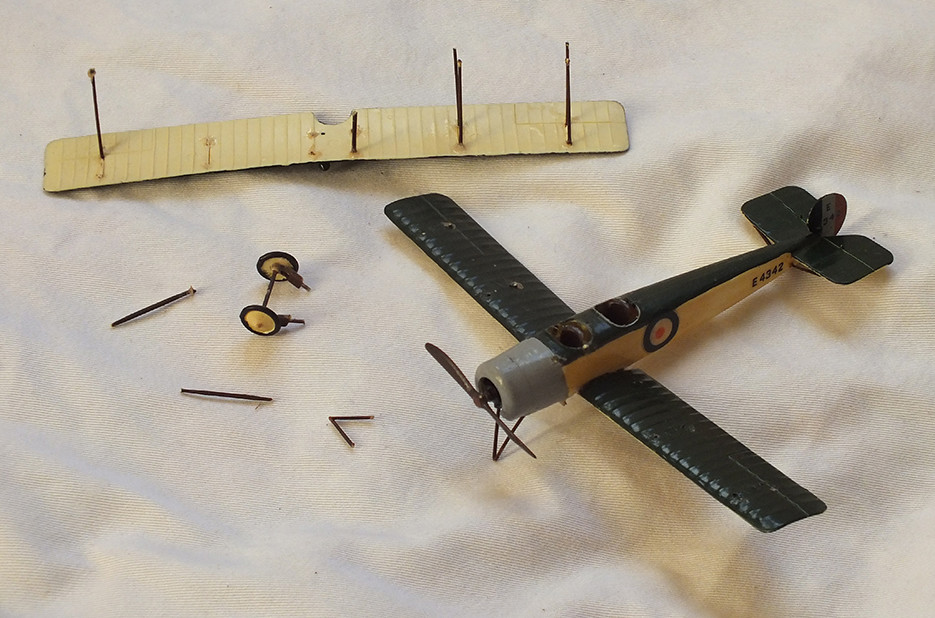 A shame because it was one of my favourites. Fortunately it was only missing the skid and a few inter-plane struts, so I decided to replace these with sprue. While researching I discovered there was a 504N conversion kit available from a manufacturer called Kora.  The “N” had a radial engine, different undercarriage and no skid. I formulated a plan. As the Airfix 504K was still readily available second hand, I decided to buy another kit and a Kora conversion. This would provide a new undercarriage and skid for my original one. This second kit was acquired. 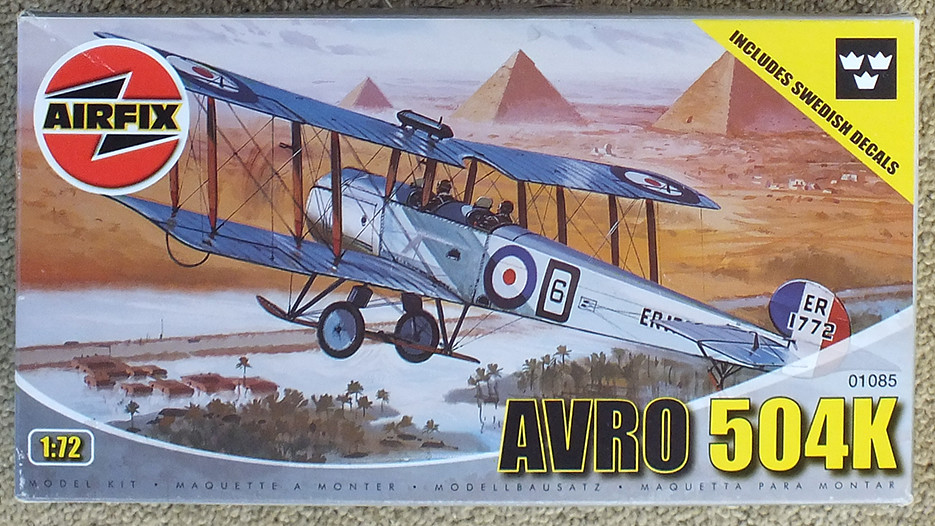 It had three decal options: the light grey one on the box art (Egypt 1920s), another grey one for Sweden in 1924, and an olive drab First World War one preserved at the RAF Museum in Hendon. As I had seen the one at Hendon I decided to buy a third kit and model that too. 
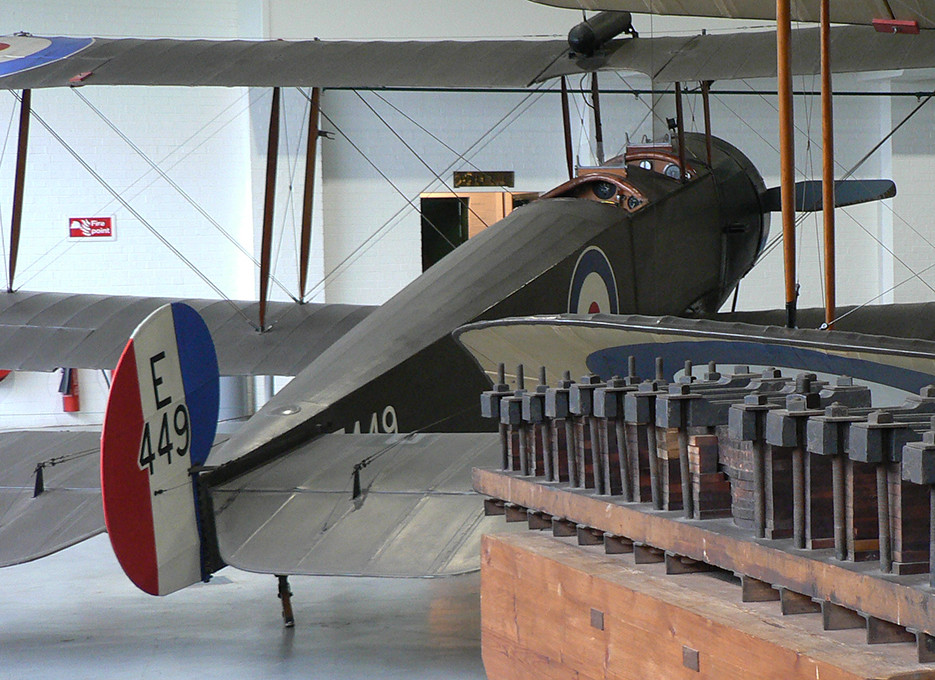 Then, the more I looked at the box art the more I liked it, so a fourth was bought to build the No.4 Flying Training School, Abu Sueir option.  I began to repair my first one (E4342) and build the second “Hendon” one (E449) together. In retrospect this may have been a mistake. The “new” kit was identical to the original other than the colour of the plastic. The fuselage halves fit on these kits had never been corrected since it was introduced in 1967 and remained terrible. Add to that the numerous ejector pin and sink marks meant there was a lot of filling to be done – times two. While waiting for the Tamiya Putty to harden I made my next mistake and started on an Airfix P-51D. The idea was just to do some prep and paint the cockpit sides etc. While I had the paint out, why not do the same to the Italeri P-51D in the stash? I now had one rebuild and three new builds on the go. What started out to be a more efficient “production line” method soon had me bogged down. However, I stuck to it. After a while I had both 504 fuselages filled, sanded and ready for paint. I had deliberately left E4342’s sides untouched as I wanted to preserve as much of the original kit as possible. Imagine my disgust when I masked along one side and removed some of the serial number in the process. A hunt through the decal box turned up a sheet of serial numbers, but the font wasn’t quite right! Oh well, I’d worry about it later.... When I decided to get back into modelling, I spent a lot of time being inspired by Googling how the experts did it – including our own Zac Yates. One thing I decided was that rigging 1/72 bi-planes was a bridge too far for me. However, despite my urge to “crack on” I soon found myself buying a reel of 6lb fishing line, a 0.5mm drill and some super glue. What followed would try the patience of a Saint, but is worth it. It isn’t a complete rigging job – more of a token gesture - but enough perhaps to convince the eye without cluttering the look too much. I also cut and “posed” all the control surfaces on E449, and just the elevators on E4342. This was a first for me, but I’ll do it sparingly. While buying some other second hand kits I was offered another 504K sight unseen and thought, “Why not?” I was delighted to find it was an original issue!  This solved my decal serial number problem, and provided another example to add to the squadron. Maybe I’ll build F9753 too. So, after a lot of interruptions and wandering concentration, both E4342 and E449 were finished. I’m pleased with the result, but they consumed more time than I care to admit. Perhaps the first build after my fifty-year sabbatical should have been something less challenging. I’ll get a few monoplanes under my belt before returning to bi-planes - and then maybe a single-bay. But I still love Avro 504s..... 


 |
|
|
|
Post by chbessexboy on Dec 11, 2021 20:24:30 GMT 12
This Republic F-84 Thunderjet was introduced by FROG in 1956, so is possibly my earliest kit – although this example would have been produced locally in the late 1960s.  Being very early means it’s also very basic. The pilot was moulded on each fuselage half (but removed in accordance with my “no pilot” policy), and wheel wells were not opened up, just painted on. It seems unlikely that Republic followed boiler making techniques when constructing their “state of the art” fighter-bomber, but it appears FROG were not aware of this. Decals of this era were not exactly transparent when new so it’s unsurprising that they have yellowed over the last fifty years. Fortunately replacements are available. Although I always associated the Thunderjet with the ‘50s, it never occurred to me it was designed as a replacement for the P-47 Thunderbolt and was in fact conceived in 1944. It evoked memories of the 1950s TV version of “Flash Gordon” I suppose. Its actual development was not without trouble. Structural failures and the usual weight increases stressed the already underpowered jet engines of the era. Despite this it featured heavily in the Korean War despite being a generation older than the Mig-15s it encountered, and sometimes shot down - but usually at a cost. The high B-29 escort role was soon given to the F-86 Sabres, and the Thunderjets concentrated on ground attack duties. With the usual rapid development of military aircraft, the F-84s were replaced and found their way to air forces of less affluent countries. Wikipedia tells us over a dozen such had them on strength and that the “Royal Thai Air Force operated 31 Republic F-84G from November 1956 until 1963”. However I swear I saw about half a dozen lined up at Bangkok airport in 1975. Maybe if they were still serving in the training role that doesn’t count. My Thunderjet will get a rub down to remove some of the excessive “detail” when it gets a repaint and a new set of decals. Until then it waits its turn on “restoration row”.  |
|
|
|
Post by chbessexboy on Dec 26, 2021 20:02:57 GMT 12
My Dornier Do 17Z-2 “5K+DH” is a FROG kit from 1971. It represents an aircraft operated over Britain in September 1940. 

 This much publicised photo (below) shows two Dorniers on the first day of London’s Blitz – September 7th 1940. The shadows tell us it is late afternoon on what was a sunny Saturday in that “Indian Summer”.  With computer tools available now, the image has been cleverly superimposed on to Google Earth to give an accurate location. Directly below the leading aircraft is Canning Town.  On that fateful day, a little girl who would become my mother was living with her family in Canning Town. Her father was employed on the nearby docks. When the air raid sirens sounded, my Mum’s favourite Aunt was caught between two shelters. She was killed in the attack. Within a few weeks my mother and her family had been bombed out. This is the expression she used to relate that, upon emerging from their Anderson shelter, they discovered their house had been largely destroyed. The targets were of course the nearby docks, but pin-point accuracy was not possible. It would be naive to think that the dockers who lived nearby were not secondary targets. The first bombs dropped on Central London are recorded as being by accident on 24th August as aircraft drifted off course from their intended military targets on the outskirts. A reprisal raid on Berlin by Blenheims followed on the 25th. Hitler is said to have been outraged and ordered the “Blitz” that started on September 7th and continued for 56 of the following 57 days and nights. These events took place only eighty or so years ago, and in the context of man’s evolution, that is nothing. Despite our belief that we are perhaps more sophisticated and evolved, recent political and social events tend to support the argument that we are the same people. With that iconic photo, we can put ourselves in a Dornier looking down on two other members of the 300 strong attacking force. That the Luftwaffe dropped high explosives on Greater London can seem incomprehensible when one visits the city now. Some of the crews would most likely have been familiar with the districts they were flying over – such was the close ties the two countries had formed since the Great War. Did they not suspect Britain would be a very different prospect from the European countries their Blitzkrieg tactics had been so successful over, and that the RAF would be capable of returning the favour? I suspect some did. I have great sympathy for those who realised at that early stage that Hitler had gambled and already lost. They “sowed the wind and reaped the whirlwind”. The devastation of Germany that followed is still the subject of hot debate. There are only losers in war. Some aeroplanes, even though their sole purpose may be what we euphemistically call “strategic”, can still be objects of interest and even things of beauty. But we must never forget their true purpose. That is why preserved examples in museums are important and the same case could also be made for models. A museum in miniature perhaps?  |
|
|
|
Post by thebrads on Dec 26, 2021 21:53:19 GMT 12
Excellent post. Well done
|
|
|
|
Post by chbessexboy on Jan 15, 2022 17:16:44 GMT 12
The humble Tiger Moth is the subject of this instalment, made even more humble by Airfix’s 1957 toy-like effort. My 1960s’ example is displayed here “as built”. 
 Even the bag-header artwork made no secret of the fact that the kit’s serial numbers were grossly over scale, and the out-of-register roundels did nothing to improve the situation.  The re-tooled Airfix 2014 release is so superior that the original is hardly worth bothering with. It would take a large dose of nostalgia, and an equal one of masochism, to build an early one now. But in already having one, I felt compelled to at least try to bring it up to an acceptable standard. So the lumps and bumps were smoothed out, and the decals (I called them transfers back then) sanded down and painted over. My 0.5mm drill got an airing, along with the fishing line and a fresh tube of super-glue. A new Airfix Tiger Moth gave up its RAF roundels (I’ll build the RAAF version) and a Ventura sheet provided the serials – each minute letter and digit painstakingly applied individually. “K2567” was the first production de Havilland DH.82 Tiger Moth of nearly 9000 built, and I consider myself privileged to have flown a couple of them. Not an easy aircraft to master, which is why it became a good trainer. However, my experience was compromised by having learnt on later monoplanes. Biplanes, with their combination of generous wing area and high parasitic drag, would have been the norm to ab initio trainees of the era. They were also young, with sharper reflexes..... My “K2567” may not be the most accurate 1/72 Tiger Moth, but it’s the best I can make it and I’ve enjoyed the process – which after all must be the object of the exercise. 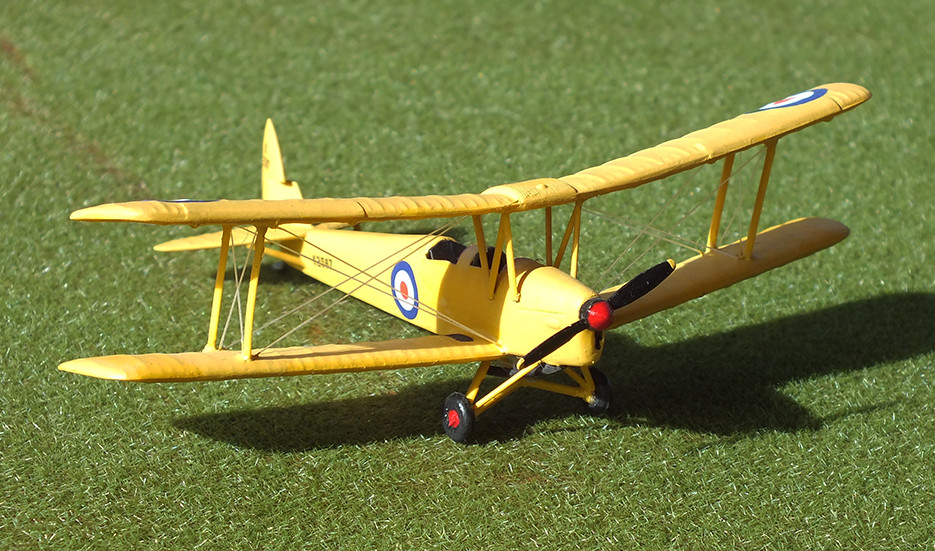
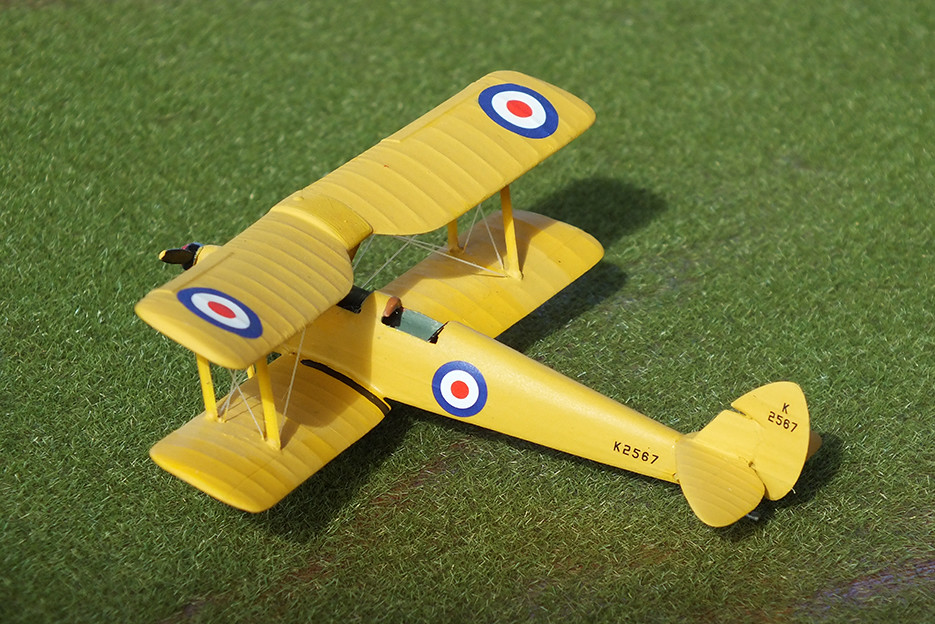

|
|
|
|
Post by chbessexboy on Jul 2, 2023 16:54:52 GMT 12
Since I finished the Tiger Moth, so much has happened to interrupt progress on the previously mentioned Mustangs that were started while working on the Avro 504s. A succession of house moves, catching Covid, retirement (which should have created more time but, which everyone finds, doesn't), the return to flight of a couple of 1/1 aeroplanes (and coming to grips with flying a couple more), becoming involved in a full-scale 1913 reproduction aircraft, and Cyclone Gabrielle thrown in for good measure. I’m not short on excuses. Back in the 1970s I didn’t build any 1/72 Mustangs. I already had a 1/50th RSL P-51D and I concentrated on modelling as many different subjects as I could afford. Now, with the range available, it’s possible to cover virtually all the stages of development from the A-36 Apache to the F-82 Twin Mustang. However, I do enjoy subtle variations on a theme, so an early D without the fin strake was on my wish list. As far as I’m aware, this is one kit that does not exist in 1/72, so I purchased an inexpensive Italeri “Speciale Italia” post war boxing and some Usk decals produced in Washington, USA.   Removal of the strake was of course straight forward, helped with a little Tamiya putty. I was attracted to the aircraft depicted because of its overall olive drab scheme – a change from the usual highly polished aluminium commonly associated with USAF P-51Ds. But by way of contrast, I decided to simultaneously build an Airfix “Red Tail”. 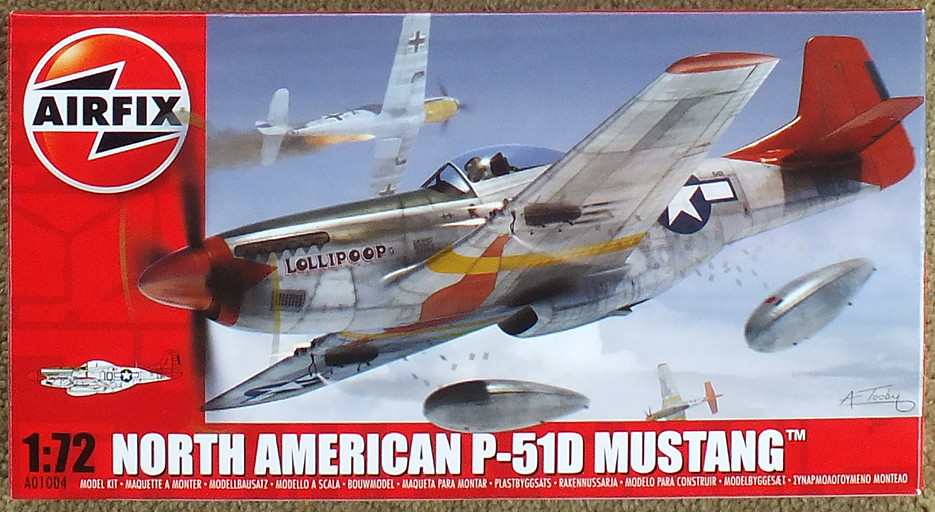 I discovered that these two kits are quite complex, with a considerable parts count – at least I thought so, since I’d last attempted something similar half a century ago. I don’t believe these models are aimed at twelve year olds, and if they are, then I’m greatly underestimating current youths’ attention spans. In fact I’d go as far to say they are complex just for the sake of it. This theory will be put to the test when I build old Revell and Monogram Mustangs in the stash. Perhaps they will pale by comparison. I really thought these “modern” kits would overcome some of the faults of the earlier ones, but I was disappointed. Some parts just did not fit on either kits – like u/c doors, drop tanks and exhaust stacks. They really did test my patience. While trial fitting an Airfix exhaust it disappeared from my tweezers and took five minutes of grid search to find – only to discover two exhaust stacks had broken off. Another case of one step forward and two back. Some parts were so fine they were useless. The Airfix radio mast was covered in flash and so thin it broke in half when I tried with great care to remove it from the sprue. Like the exhaust stacks, replacements had to be made from rockets, Not only were the builds complicated, but the colour schemes were too. The Yanks are fond of stripes and chequer boards. On the Airfix kit, I didn’t like my chances of getting the yellow wing stripes to line up, so as I was using Tamiya 5mm tape on the wings of the Italeri kit, I decided to do the same on the Airfix one. By painting the yellow first, then masking over them, I had a perfect guide to apply the decals onto. These fiddly colour schemes and multitude of decals, were not necessarily the fault of the kit or decal manufacturers, after all, they were being faithful to the original aircraft, but I was keen to complete the models and move on, This was compounded by the fact I was building two together, and had set my hopes on a high standard of finish. Paint became a problem. The Olive Drab was easy with the old faithful Humbrol enamel, but highly polished aluminium is impossible with a brush. The airbrush was still packed away somewhere in the box it came in, so I bought a rattle can of hardware store “chrome”. A test piece proved I was on the right track and a first coat looked great, but the second reacted down the starboard fuselage side for some reason and I was back to square one. A complete rub down and repaint with Tamiya lacquer finally achieved the result required and allowed me to progress to the next stage. But the set-backs continued. The windscreen on the Italeri model was a poor fit and broke in half while I was filing it to shape. I was taken by surprise as I didn’t think I was being rough with it. I had another Italeri P-51D in the stash so found that and continued. I was being extra careful but when I almost had it fitting it broke too. Clearly there was a penalty for making them so thin. Luckily Jays had “Squadron” vac-form canopies in stock so I bought some. They arrived (with other goodies to take advantage of postage) in three days, allowing me to continue. Although designed for the Hasegawa kit, it also fitted the Italeri with some trimming. Using a vac formed canopy was a first and there is plenty of scope for me to improve my skills next time. Another first was posing the Airfix canopy open – never an option fifty years ago. P-51s are covered with a multitude of stencils, and many were included in the Airfix kit, but I was concerned they were over scale and would spoil the look of the finished model, so I chose to only apply the major ones. The Italeri kit using the after-market decals didn’t present the same problem with the olive paint.  John Brooke England enlisted in the United States Army on 1st April 1942, was accepted as an aviation cadet and sent to Yuma, Arizona. On completing his flying training, he joined the 362d Fighter Squadron of the 357th Fighter Group, flying the P-39 Airacobra. In December 1943, the unit was assigned to RAF Leiston in Suffolk, England. After retraining on the P-51 Mustang, they flew their first combat mission on 11th February 1944. At first flying P-51B “U’VE HAD IT!”, he rapidly rose through the ranks. Promoted to major and continuing to fly combat sorties, by then in P-51D “Missouri Armada”, his final tally was 17.5 enemy aircraft destroyed in flight.   Major England served briefly in the Korean War, but was killed in bad weather trying to land an F-86 Sabre in Toul, France, on 17th November 1954.  Spurgeon Ellington was an elementary school teacher in civilian life. He enlisted in 1942 and was trained as a pilot at Tuskegee Army Air Field, Alabama  Lt Ellington flew with the 100th Fighter Squadron and, in February 1944, the 100th, 301st and 302nd fighter squadrons arrived in Italy. Together with the 99th, these squadrons of Black pilots and other personnel made up the new 332nd Fighter Group flying P-51 Mustangs to escort heavy bombers deep into enemy territory. The tails of their planes were painted red for identification purposes.  Ellington’s personal mount in December 1944 was P-51D “Lollipoop” based at Ramitelli, a temporary airfield southeast of Campomarino in the north of Apulia, Italy. He flew 124 missions, earning an Air Medal with four oak leaf clusters and the Distinguished Flying Cross.  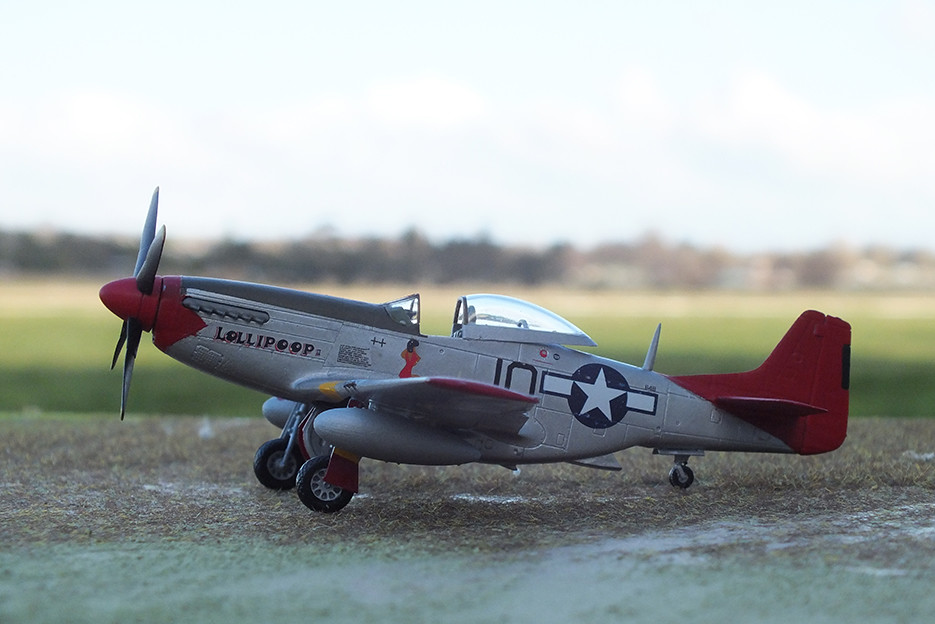 Surviving the war, he was killed along with another pilot during a training exercise at Crystal Lake, Georgia in 1945. Although the aircraft in question would never have been operated from the same field, I was keen to see them side by side when finished.   These two Mustangs have taken way longer than they should have, due to their complexity, my wandering attention, a desire to take the care required for an acceptable finish, and many interruptions. Their excessive detail came at the cost of ease of assembly and severely impacted the enjoyment of their construction. Modelling is supposed to offer some relaxation but these two kits just provided a lot of frustration. It was only through dogged determination that they were finished – the main incentive being that I could then build something else. It was while I was finally tidying everything P-51 related away, that Airfix had the last laugh – as I picked up the box, I noticed on the side it said, “Skill Level 1, 8+”. |
|
|
|
Post by Deleted on Jul 2, 2023 17:23:00 GMT 12
Lovely work Ron! I quite enjoy the New Airfix Mustang and you’ve done it justice here.
|
|
|
|
Post by chbessexboy on Jul 2, 2023 17:36:29 GMT 12
Lovely work Ron! I quite enjoy the New Airfix Mustang and you’ve done it justice here. Thanks Zac. It was a struggle but I don't like to be beaten. I have another Airfix Mustang to build but I'll get some more skills before I attempt it! |
|
|
|
Post by chbessexboy on Jul 15, 2023 15:32:21 GMT 12
A dilemma: what to do with old models? As I have illustrated in this thread, I have all my kits from the ‘60s and ‘70s, and also a few of my sons’ built when they were very young. Their build quality is reflected in the age of their builders, and being early kits anyway, their accuracy falls a little short. With the current trend of super-detailing and high standards of authenticity, they inevitably struggle to live up to my latest efforts. Should they be banished to a cardboard box because they are “not good enough”? I think that would be a great shame, especially as I am nostalgic and sentimental to a fault. I’ve decided on a programme of sympathetic restoration: repairs as required, repaints or touch-ups where necessary, and new decals - retaining their identities wherever possible. They will never be as good as the current crop of offerings, but they will become as good as can be without losing their provenance. Maybe first up in “Restoration Row” will be these Hurricanes:  |
|
|
|
Post by planecrazy on Jul 15, 2023 17:28:44 GMT 12
Keep them one day there may be grand kids, threat them as family heirlooms,
had a few models I built many years back, gave them away, regret it to this day?
|
|
|
|
Post by chbessexboy on Oct 16, 2023 18:04:00 GMT 12
With the very near completion of another model, the fun of photographing it has been dulled somewhat by recent events. This forum has added dimensions to my modelling that has developed it far more than it was to me as a child. The research, writing, photography and “set making” I find enormously rewarding. It matters little if nobody bothers to read this – the satisfaction and pleasure has already been achieved.
However, the conflicts that have developed in Ukraine, and now Israel, have made me reflect on my motives. I am not altruistic. Scenes of war on the television news has forced me to turn it off – it is so upsetting.
Being interested in “Warbirds” and building models of them does not make me a warmonger. It may sound laughable, but the fact is that men will wage war irrespective of whether I build 1/72 kits or not. So I will continue, perhaps in this small way, to acknowledge those who flew these aircraft to bring peace.
|
|
|
|
Post by chbessexboy on Oct 17, 2023 18:40:39 GMT 12
Who doesn’t like the "Jug”? It could only have been built in America. A fighter as big as a block of flats, giving the impression of having the finesse of a blunt instrument, while concealing incredibly complex systems for its turbocharged R-2800. Once they had overcome the shock of the sheer size of the machine, pilots became devoted – in some cases resisting the eventual conversion to P-51s for as long as they were able. I’ve always loved them. The first one I saw “in the flesh” was by pure chance. I was pushing my son Ricky in his “baby buggy” the back way from MoTaT to the Meola Road collection, when we came across one sitting outside, by itself, looking forgotten and lonely. Surprise doesn’t begin to describe the encounter.  (Phillip Treweek photo) I subsequently learned this was 42-8066, reputedly the oldest surviving P-47. It was operated in New Guinea by the 4911(F) group. Recovered in 1975 by Bill Chapman and Charles Darby from a swamp about 40 kilometres from Port Moresby, it had forced landed after running out of fuel. Although appearing complete, it had understandably suffered from its time submerged and had some non-standard internal structures to hold it together, as well as galvanised iron and fibreglass panels. It was last reported in Australia being restored to fly, and I believe it’s well on the way to achieving that. The only other one I’ve seen was at Duxford in the American Air Museum. Coincidentally I was with Ricky again on that occasion too, but by then thirty years had passed us by. 
Having embarked on a couple of reasonably long-term conversions and wanting something quick and simple to maintain my enthusiasm, I chose an Academy offering, thinking that surely the award winning Korean company could put me back on track after my P-51Italeri/Airfix nightmare. I picked up this example with really nice box artwork.

However I am becoming more inclined to build subjects with a little more relevance to my own reading and New Zealand involvement. Xtradecal provide options for SEAC (South-East Asian Campaign) schemes that include one for 258 Squadron:

Construction began as usual with some trial fitting. We didn’t get off to a good start when the engine cowling didn’t really have anything to locate it, and the internal ducting below the engine had to be fabricated to more closely resemble the original. But after that it was just how I remembered model building should be. Academy are uncomplicated, like my 1970’s kits, but with generally higher standards of molding and detail. And they are not expensive. Before long I had this 258 Squadron example: 
Created in the First World War and flying DH.6s, the squadron was reformed in November 1940 with Hurricanes. Squadron leader was Wilf Clouston, who learned to fly in Wellington. He traveled to England and became a pre-war regular with 19 Squadron flying Gauntlets and then Spitfires - the first squadron to receive them. Wilf was busy distinguishing himself in the Battle of Britain, when he was given the job of working a Hurricane squadron up in a “quiet” posting on the Isle of Man. After eleven months and much relocation, 258 arrived at Kenley for the offensive into Europe. But it wasn’t to be.
To quote Wiki:
“In October (1941) they were stood down to prepare for a move to the Far East. After a few days in Singapore, they were withdrawn to Sumatra and then Java, where they suffered many losses either killed or captured by the Japanese. The survivors transferred their aircraft to No. 605 Squadron and most attempted to escape by ship to Australia, but all the ships were sunk en route with no survivors.”
258 squadron was reformed in Ceylon, again on Hurricanes, and with predominately RNZAF members. Sadly, action in April 1942 against the Japanese carrier force saw the squadron decimated. Brought back up to strength and by now operating in Burma, they were withdrawn to India and re-equipped with P-47 Thunderbolts.
At last given the tools to do the job, they began working up in preparation for the invasion of Malaysia. We cannot possibly imagine the emotions they felt when the Japanese surrendered without 258 having to fly their Thunderbolts in action. A protracted ground attack campaign over unforgiving country would have been another death sentence.
So here is “Republic P-47D-RE 44-20963 Thunderbolt Mk.II, KL314, ‘ZT-W’ of 258 Squadron, based at Kuala Lumpur, Malaysia, late 1945.”


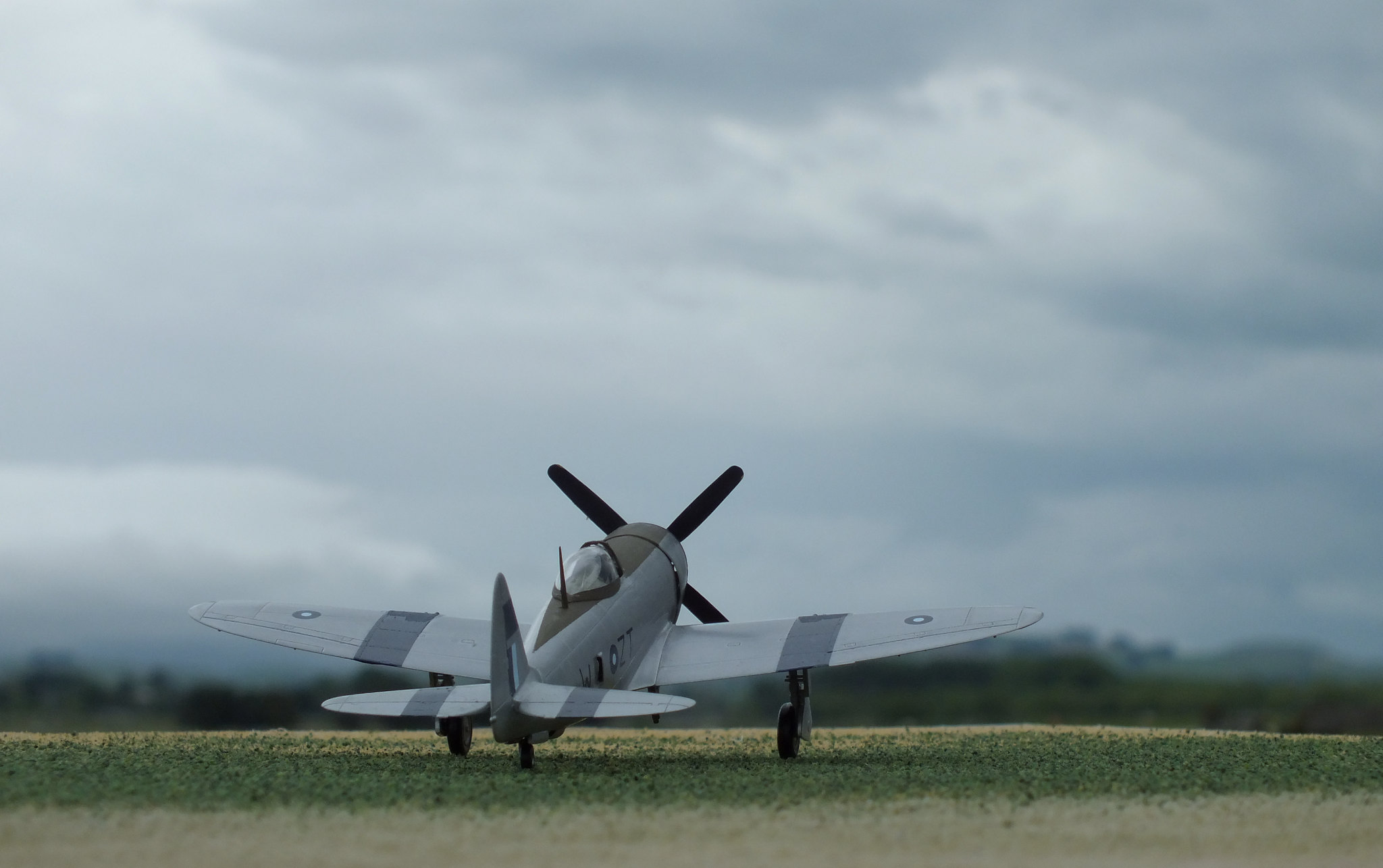 |
|
|
|
Post by chbessexboy on Oct 31, 2023 15:55:27 GMT 12
When I was building kits over 50 years ago, I naturally kept all the bag headers and instructions. Why I no longer had them became a mystery. Having recently sold a large house I'd lived in for 26 years, and in clearing it not discovered them, it remained unsolved. Next to be cleared on the property was an old shed measuring 21 X 5 meters full of vintage and classic cars, associated parts, furniture and ephemera. It was a mammoth task that consumed several months. When it was finally empty, and before a last sweep out, I walked through its length checking I'd not missed anything hiding on the many rimu dwangs. As I reached the very end, and was turning away, something caught my eye on top of the old wooden fuse box cabinet fixed high on the back wall. Two small boxes.  Going through the contents transported me back to my childhood.  |
|
|
|
Post by Antonio on Oct 31, 2023 16:11:08 GMT 12
Oh wow!
Who hasn't built at least one of them in their lifetime......
|
|
|
|
Post by chbessexboy on Oct 31, 2023 18:34:40 GMT 12
Oh wow! Who hasn't built at least one of them in their lifetime...... And this is only some of them Antonio! |
|
|
|
Post by chbessexboy on Nov 1, 2023 11:34:39 GMT 12
When my SEAC Thunderbolt II was well on the way to completion, and my other longer-term projects far from it, I decided to drag a couple more P-47s out of the stash. I was enjoying the Thunderbolt and felt like building more. Among others, I had a second Academy "Bubble Top" and a Hobby Boss example to build. I decided the Academy P-47 would be painted as a bare metal Duxford based example using an alternative set of Tamiya decals.  The Duxford based 84th Fighter Squadron, 78th Fighter Group was more often than not allocated the job of escorting bombers as far as they could into Germany, or flying out to meet them on their way back. A drop tank was therefore appropriate.  WZ*P was the mount of Lt.Col Benjamin Mayo, Squadron Leader of the 84th.  Hobby Boss introduced a method of splitting the fuselage horizontally with the lower half having wings already attached. This is a great idea for youngsters to get started. It’s also a fun way for older modelers to get some instant gratification! The mouldings are first rate but dimensions are not always accurate. Their intended market would not be bothered, or even be aware of this, and it’s unfair to criticize them for it. There are plenty of kits with higher accuracy, and correspondingly higher prices, for the serious modeler to build. As Hobby Boss produce a lot more than just 1/72 aircraft, I can’t comment on their other subjects and scales. For these they may invest more time in creating their moulds. 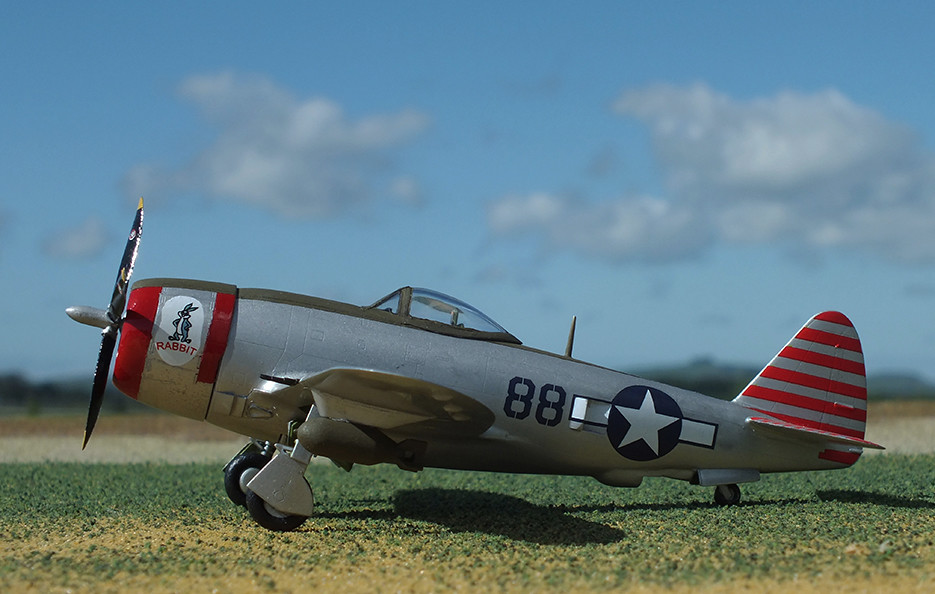 Number 88 "Rabbit” operated out of Pisa with the 527FS, 86FG. Their role was mainly as a close support unit, so I fitted a pair of 500 lb bombs. They took part in the invasions of Sicily, mainland Italy and the south of France, before ending the war operating over Germany. Their aircraft were numbered from 70 through to 99. 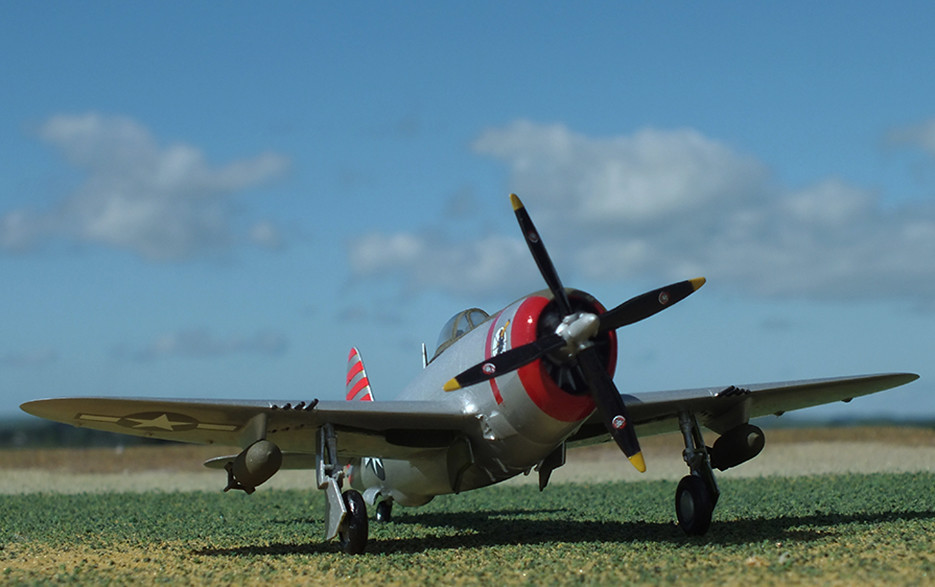  Although "Rabbit" is a popular subject for kit and decals producers, the name of the pilot has yet to be discovered.    |
|
|
|
Post by chbessexboy on Nov 21, 2023 15:29:16 GMT 12
When Sir Tim Wallace sadly passed away recently, I watched the old TV3 doco again “Beating the Odds – the Story of Hurricane Tim” via YouTube (thanks for the link Zac). It got me all fired up about Polikarpov I-16s. The rabbit hole took me on to Kermit Weeks’ videos of purchasing the example restored for the Alpine Fighter Collection and later sold to the American Heritage Flying Museum in Massachusetts. I am very fortunate to have seen one at Wanaka in 2006.  I thought it was time I put a Rata in the collection, and the kit I had was a real blast from the past!  Online reviews of the Revell Polikarpov are not particularly kind, but we should be grateful it was a subject chosen to be modeled at all. Perhaps it is not particularly accurate, but it was first released in 1964 and I’m sure the toolmakers didn’t have access to one to measure. Having said that, there wasn’t much to it:  I found it went together pretty well. I did glue the cowlings closed though, rather than have them removable, as the engine isn't really good enough to display. I also added a cockpit floor, an instrument panel and control column, but they’re all hardly visible. My tube of Tamiya putty was put to use on the wing roots, but for a kit of this vintage that was no real surprise. The original red stars seemed to be oversize so I chose some from an AMLD set. Fortunately the "White 4" decals in their distinctive font were usable. I think the end result looks like a Rata, and that is what counts.  |
|
|
|
Post by Deleted on Dec 1, 2023 19:07:59 GMT 12
I remember being a Poli-mad kid and very jealous of a friend who had this kit, so I'm always happy to see it. Lovely job Ron!
|
|